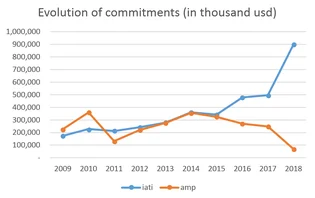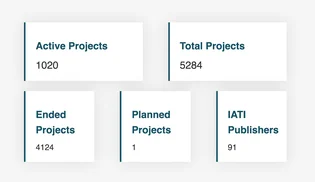Discovering 830 million dollars of spending in Madagascar
The Government of Madagascar uses IATI data to discover millions of dollars of spending on development and humanitarian projects in the country, that were previously unknown to them. This invaluable information helps improve planning and coordination of aid.
"Analysis from the government of Madagascar shows that over the last 10 years, IATI data revealed an additional USD 830 million worth of spending commitments"
The outcomes
The Government of Madagascar uses IATI data to discover millions of dollars of spending on development and humanitarian projects in the country, that were previously unknown to them. This invaluable information enables the government improve the planning and coordination of aid.
Effectively plan for the future
Government staff are better able to plan for the future by using forward-looking data from IATI to find out what donors are planning to spend in the country, several years in advance. Analysis from the government shows that over the last 10 years, IATI data revealed an additional USD 830 million worth of spending commitments, compared to data obtained by the government from direct requests to the same donors.
The chart below shows a significant increase since 2015 in donor commitments that were found by using IATI’s online search tool, d-portal.org, compared with data in the government’s internal aid database, called the Aid Management Platform (AMP).

Volume of data on spending commitments published to IATI compared to data in Madagascar AMP (2009 - 2018)
As a result, government staff use IATI data to better plan and coordinate their domestic resources to complement the spending of external donors. For example, the Ministry responsible for Water, Sanitation and Hygiene (WASH) has launched a database called TRACKFIN that uses IATI data to track down all financing to the WASH sector. This helps staff to better understand where service gaps or duplications may exist in the future.
Establish working relationships with more donors
The government uses IATI data to improve coordination with donors and other organisations who do not report their development or humanitarian activities directly to the government often because they do not have representative offices in the country.
Currently, 38 organisations, from donor governments to multilaterals and NGOs publish information on their spending and projects to IATI, and their data are not included in Madagascar’s AMP. Their data represents an additional USD 288 million of spending commitments and over USD 300 million of actual spending and disbursements on development and humanitarian activities.
Not only has additional funding been identified, but the government has also discovered organisations they had not been aware were active in Madagascar. With contact information shared through IATI, this has enabled government staff to make contact with them, and start working together to deliver a coordinated effort to help improve development effectiveness.
Save valuable time processing aid data
In a recent pilot undertaken with UNICEF (see below), government staff saved valuable time by trialing an IATI data synchronisation tool, since they were no longer required to input aid data manually into the Madagascar AMP. The tool automatically imported 118 development projects into the AMP, that UNICEF had originally published to IATI.
What happened
Within the Government of Madagascar, aid data is managed in the Office of the Prime Minister by the Permanent Technical Secretariat for Aid Coordination (STPCA). This body was created in 2008, along with Madagascar’s AMP (developed by Development Gateway), which became their first national database to manage data on aid coming into the country.
Step 1
In 2011 the Government of Madagascar signed the The Busan Partnership for Effective Development Co-operation, strengthening its commitment to transparency and open access to development data. In the same year, the government took the decision to become a member of IATI. As a member, Madagascar committed to using IATI data and addressing the challenge of harmonising the data collected by government staff from donors based in the Madagascar, and the data published to IATI.

IATI data published on Madagascar 04 July 2017. See up-to-date statistics on d-portal.org
Step 2
Over the next four years, the availability of IATI data steeply increased, from the first organisation publishing their spending in 2011, to over 370 publishers in 2015. In 2015, with the support of the French Ministry of Foreign Affairs, the government implemented an IATI import tool to automatically input IATI data into the Madagascar AMP.
In 2017, the government took part in a joint project with UNICEF and Development Gateway, in which the tool was adapted and successfully imported 118 UNICEF projects into the AMP.
Next steps
Following the success of the pilot, the Government of Madagascar plans to integrate other partners in their data synchronization exercise. The African Development Bank and USAID have already expressed interest in helping to automatically import their IATI data into the government’s AMP.
For Madagascar, IATI data is provided to all ministries through the AMP-Madagascar database, to improve coordination and planning of development resources.
More information
For more information on the Government of Madagascar's experience of using IATI, including information for other governments on lessons learned, see Increasing the use of IATI data in Madagascar and Senegal. To discover how to access IATI data visit Using Data.